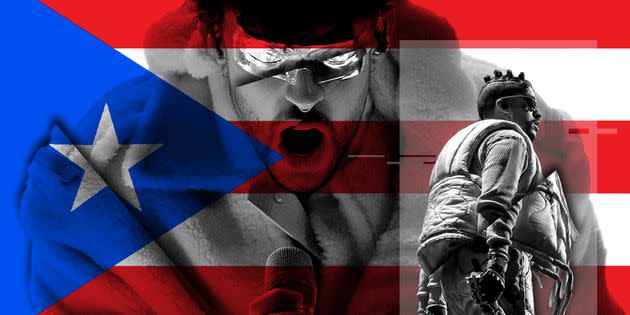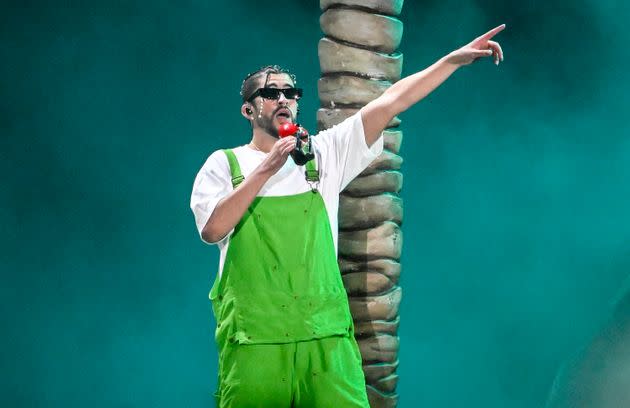Bad Bunny Is A Folk Artist First And A Pop Artist Second
- Oops!Something went wrong.Please try again later.

Despite Bad Bunny’s colossal crossover into the mainstream, his work will always signify something different to our community. (Photo: Illustration: Benjamin Currie/HuffPost; Photo: Getty)
Ask any young Puerto Rican where they were and who they were with when Bad Bunny dropped his first album back in 2018. It was Christmas Eve, and to many, it was a gift to his island.
I was in a car in Puerto Rico when I listened to “X 100PRE” for the first time, vibrating with a childlike excitement. Within seconds, my friend who was driving stopped at a parking lot so we could fully enjoy the rhythm of each song, diving into the lyrics that appeared coded specifically for those from the island.
Since then, it’s become a ritual to listen to his albums on the night they drop. I listened to “Un Verano Sin Ti” alone in bed. “YHLQMDLG” was more of a community event; I hosted a listening party in Williamsburg, Brooklyn, so my Puerto Rican friends and I could devour the album together and evaluate all the tracks in detail. Despite Bad Bunny’s colossal crossover into the mainstream, these memories resonate because his work will always signify something different to our community.
“For those of us in the diaspora, his music is a way to connect to home. It’s comforting to listen to him refer to places I used to go to when I was living on the island,” said Aurora Santiago Ortiz, assistant professor of Latinx studies at the University of Wisconsin-Madison. Scholars and teenage TikTokers alike express a sense of intimacy with the music, which speaks to us as only a local can.
One line in particular from one of his early hits, “Tú No Metes Cabra,” serves as a prophecy of sorts: “la nueva religión, yo soy la nueva era” (the new religion, I am the new era). For Puerto Ricans, Bad Bunny has served as a cultural touchstone, but to the world now, he is a ubiquitous pop icon. The man is everywhere you look: billboards, award ceremonies, magazine covers and Hollywood. Hundreds of fans of all ethnicities inked his signature heart on their bodies to celebrate a new album.

Bad Bunny performs at RingCentral Coliseum on Sept. 14, 2022, in Oakland, California. The rapper is "writing a historical account of what we are feeling and witnessing today," the author writes. (Photo: Steve Jennings/Getty Images)
During the past year, while the entire world has become enraptured by Bad Bunny, he’s been streaming incredible numbers — all while exclusively speaking Puerto Rican Spanish, retaining a crucial part of his identity.
“I always knew that I could become a huge artist without changing my culture, my slang, and my language. I am Benito Antonio Martínez Ocasio, from Puerto Rico to the world,” Bad Bunny said after he was named Artist of the Year at MTV’s Video Music Awards.
Growing up, I was made to feel that Puerto Rican Spanish — notable for its combination of Taíno (Indigenous) and Spanish sounds with African pronunciations such as “Rs” often pronounced as “Ls” — was inferior to that of other Spanish-speaking countries. To witness a Caribbean dialect once stigmatized by both Latinos and non-Latinos become part of the mainstream cultural fabric is huge. It’s a sign to the younger generations that you don’t actually need to change who you are to fit in, as other artists have done in the past.
For us, Bad Bunny will never be pop. He is a cultural storyteller, a modern-day folk artist narrating the complexity of la puertorriqueñidad. See, Boricua culture is perceived as too American for the rest of Latin America and too Latino to be considered a part of U.S. society, a dichotomy that makes it challenging to navigate life both inside and outside the island. The blended identity is often seen as too much and not enough all at the same time, which takes a toll on our self-worth. Bad Bunny’s words and swagger make us feel seen at our most powerful and vulnerable. Although his music resonates globally, he’s speaking about la brega, something only Boricuas can truly understand because we’ve experienced it.
For me, the lyrics to the songs “Como Antes” and “Estamos Bien” are unmistakably Boricua and provoke a certain nostalgia for those who grew up in the ’90s. Lyrics from the latter — “La Mercedes en PR cogiendo boquete” — describe the countless potholes Puerto Rico’s roads are notorious for. The line is a reminder of the island’s shoddy infrastructure, a sign of neglect by the larger U.S. system.
Also in “Estamos Bien,” he raps, “Pa’ casa no ha llega’o la luz,” describing the everyday reality of unreliable electricity, which is treated more as a luxury than a basic necessity by the powers that be. The lyric feels especially poignant this week, as the island, currently without power, reels from Hurricane Fiona’s wrath.
In the same song — a track that spans rage and joy — Bad Bunny raps about “Las peleas de boxeo, to’ los party de perreo.” Growing up in Puerto Rico, three events were treated as a national celebration and cause for unity regardless of one’s circumstances: any sporting event where our own represented la isla — in this case, boxer Tito Trinidad; the Miss Universe pageant; and of course, parties de marquesina. For us, despite the circumstances, partying is a radical act of resistance.
For us, Bad Bunny will never be pop. He is a cultural storyteller, a modern-day folk artist narrating the complexity of la puertorriqueñidad.
While Bad Bunny tells the world of our struggles and successes, we Puerto Ricans are the ones who can process the nuance of his stories.
“He’s one of the few artists who unapologetically speaks in his music about his culture and identity, regardless of whether others can understand him or his references,” said David Hernández, a music industry executive in Miami. “The world cannot understand most of it but he doesn’t care. On top of that, people actually learn them in order to understand him.”
In this way, Bad Bunny is our ambassador to the world.
Written amid constant blackouts in Puerto Rico, Bad Bunny’s recent ode to the island, “El Apagón,” serves as the anthem of a generation fed up with the difficulties of dealing with a crumbling infrastructure and an incompetent government while living in a tropical paradise. That’s the duality of “Puerto Rico está bien cabrón,” a prime example of this balance between enjoying life’s simplest pleasures — love, sex, going to the beach, partying — and teetering on the edge of social collapse.
The lyrics of this song are not just rallying cries to defend the patria; they’re folk music. Beyond being the voice of a generation, Bad Bunny amplifies the conversation of a particular community within Latin America, one that has lived through an economic collapse, survived Hurricane Maria, earthquakes and political corruption. It’s a generation that’s been denied opportunities, and often, a unified voice.
“Oftentimes when we think about folk music, we think about ‘El Topo’ or ‘La Canción Protesta.’ Those were examples of folk music in the moments in which they were created,” said Jorell A. Meléndez-Badillo, assistant professor of Latin American and Caribbean History at the University of Wisconsin-Madison. “Bad Bunny is the music of Puerto Rico post-2006, when the current economic crisis began. [He’s a] reflection of Puerto Rico’s reality, and his music a sonic archive of what Puerto Ricans are going through today — even when he’s talking about ‘dar tabla.’”
The artist himself apparently agrees. “I never made a song thinking, ‘Man, this is for the world. This is to capture the gringo audience.’ Never. On the contrary, I make songs as if only Puerto Ricans were going to listen to them,” Bad Bunny told writer Carina Chocano in a recent GQ interview. “I still think I’m there making music, and it’s for Puerto Ricans. I forget the entire world listens to me.”
Throughout the island’s history, Puerto Ricans have used various musical genres to express their frustration with the systems that oppress them. Salsa brought attention to discrimination and poverty within the Nuyorican community, bomba has historically played a role in the island’s protest movements, as has plena, which originated as a way to recite daily news and often satirize local politicians. It later developed into a vital part of the community’s expression, better known today as “the newspaper of our people.” Reggaetón, many can argue, has been a political tool since its inception.
Bad Bunny may not be using the traditional instruments of güiro and cuatro or reciting décimas. But he’s writing a historical account of what we are feeling and witnessing today. When I was a child growing up en la isla, my parents took me to festivals in the local plazas to witness our trovadores. With that same intention, I know I will play Bad Bunny’s “Andrea” for my future kids.
Like pleneros, Bad Bunny, the eldest son of a truck driver father and a schoolteacher mother, is a jíbaro from Vega Baja. And that chamaquito is now chronicling — and exporting — our culture worldwide.
This article originally appeared on HuffPost and has been updated.
